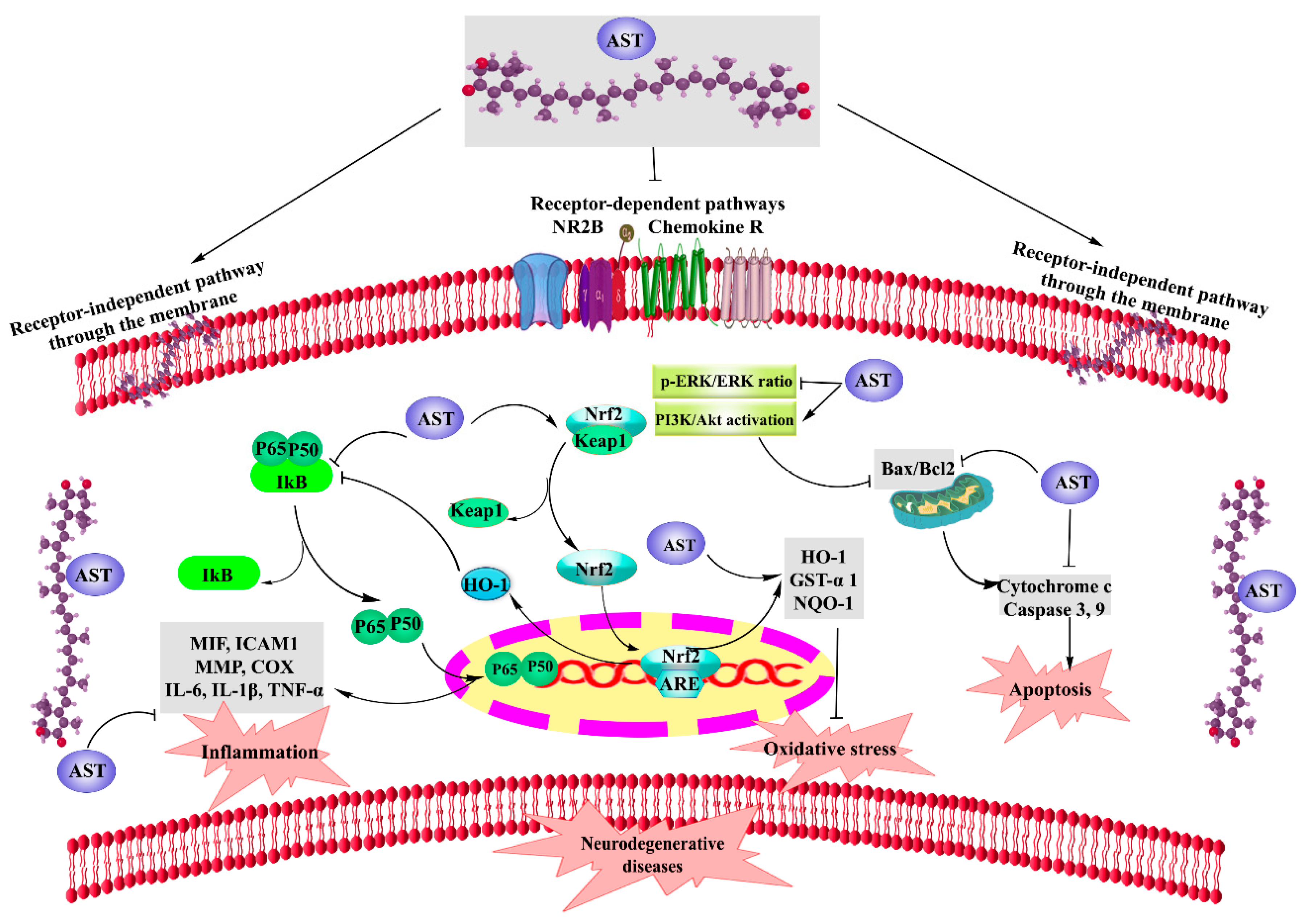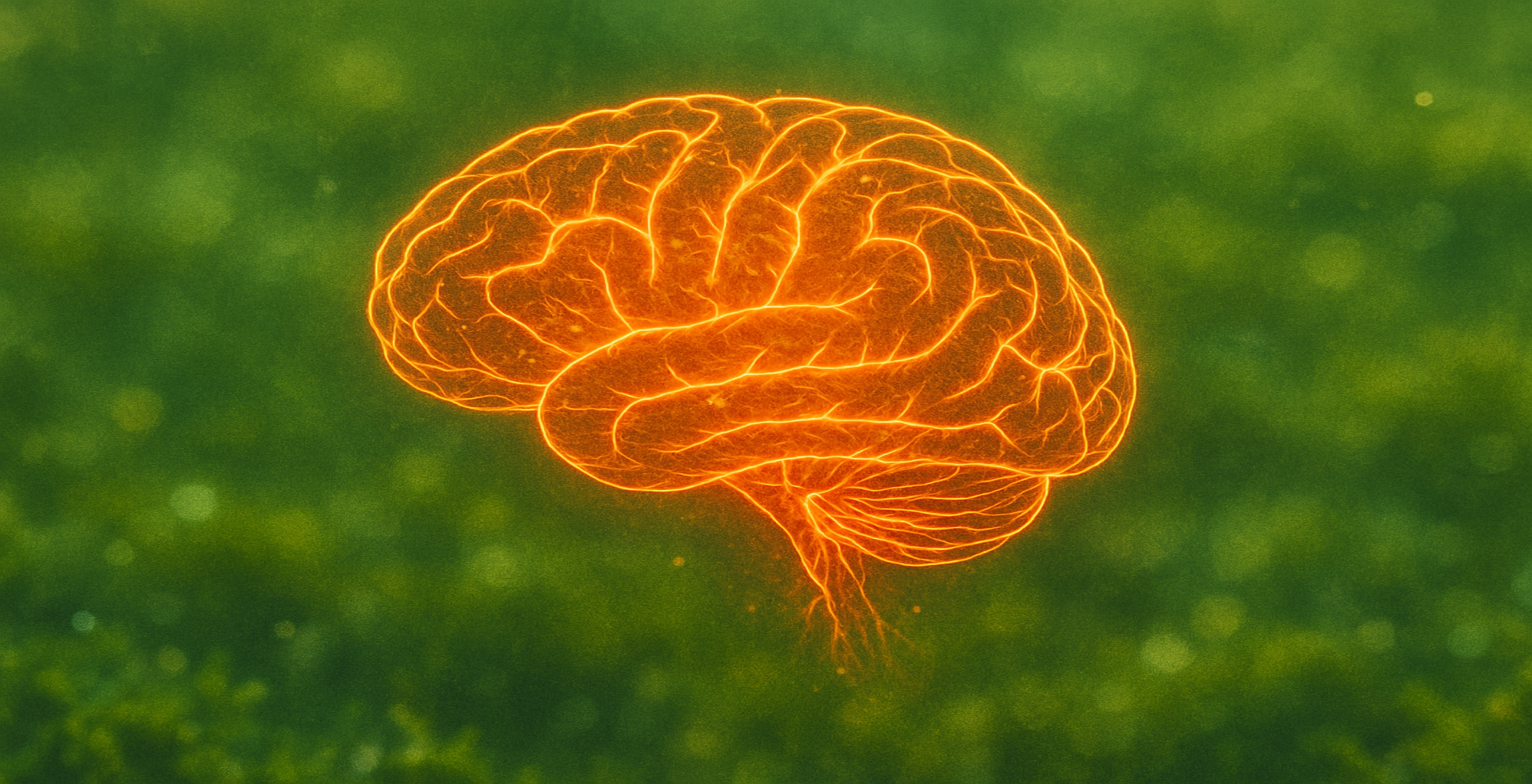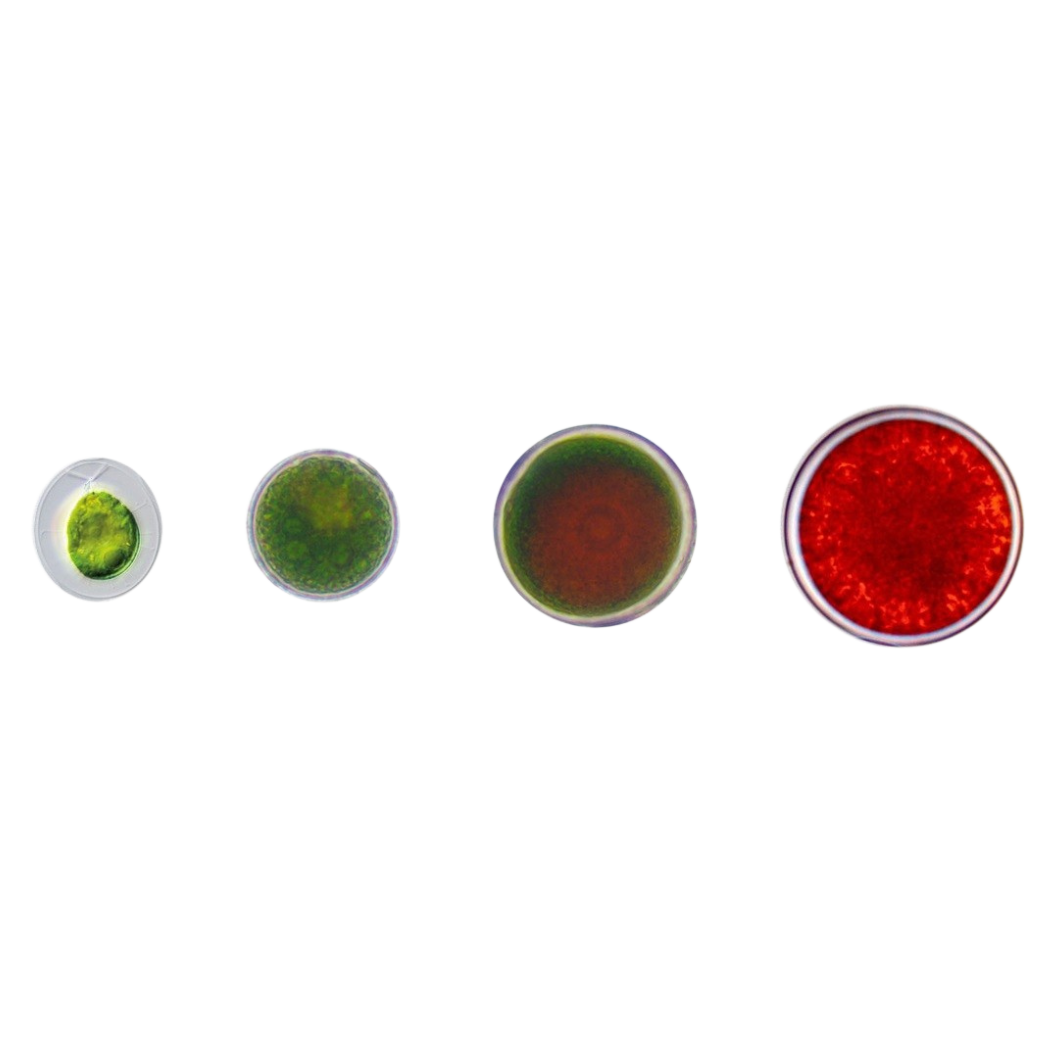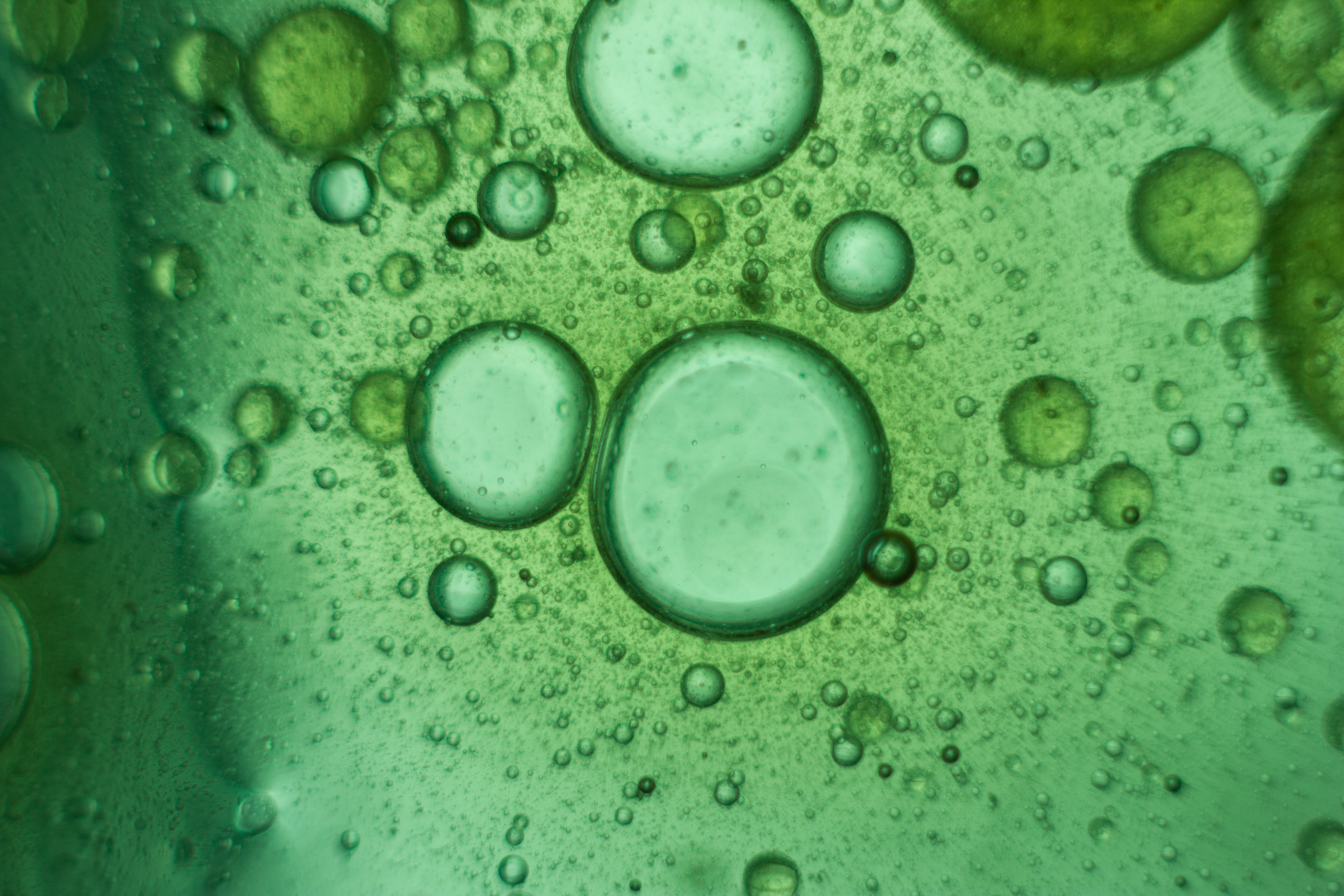Table of contents
The Comprehensive Guide to Astaxanthin's Benefits on Brain and Cognitive Health
Introduction to Astaxanthin and Its Relevance to Cognitive Function
How Astaxanthin Impacts Brain Health
Scientific Evidence and Clinical Validation
Practical Applications of Astaxanthin in Cognitive Health
Formulation, Dosage, and Bioavailability
Future Perspectives and Emerging Trends
Conclusion: Astaxanthin's Transformative Potential for Cognitive Health
Jonas De Cooman
Jonas is a bioengineer and biotech innovator dedicated to advancing health. As a co-founder of axabio and science enthusiast, Jonas possesses an inherent passion for longevity and is continually exploring the latest advancements in this field, especially those combating inflammation and increasing lifespan.
Astaxanthin's Benefits on Brain and Cognitive Health
Astaxanthin is a potent carotenoid antioxidant that offers exceptional neuroprotective benefits by crossing the blood-brain barrier and reducing oxidative stress, making it especially relevant for age-related cognitive support.
This extraordinary carotenoid doesn't just match the free-radical fighting power of other antioxidants—it surpasses many of them. By standardizing its references to Natural astaxanthin (AST) and highlighting its well-documented potency, the content now reflects a more precise, research-focused viewpoint.
In the world of antioxidants, astaxanthin stands alone as a remarkable neuroprotective powerhouse.1

What makes this ruby-red compound truly exceptional is its versatility and unique ability to cross the blood-brain barrier. Standardizing references to Natural astaxanthin (AST) underscores its potency, while maintaining a factual tone consistent with recent scientific findings.2

A comprehensive 2024 systematic review by Utomo et al. has recently highlighted astaxanthin’s potential to improve cognitive function and slow neurodegeneration, underscoring the timeliness and relevance of these findings for brain health.3
This evidence-based guide explores the comprehensive benefits of natural astaxanthin for brain health and cognitive function—from its distinctive mechanisms of action to its wide-ranging clinical applications in protecting and enhancing neurological well-being.
Takeaway: Astaxanthin's unique structure and antioxidant power make it a standout supplement for cognitive health, thanks to its ability to cross the blood-brain barrier and help protect neurons from oxidative stress.
Introduction to Astaxanthin and Its Relevance to Cognitive Function
What is astaxanthin?
Natural astaxanthin (AST) (pronounced asta-ZAN-thin) belongs to the carotenoid family, which includes compounds known for their potent antioxidant properties.
The secret to AST's power lies in its distinctive molecular architecture, allowing it to penetrate cell membranes in multiple environments. This broad reach contributes to comprehensive protection, especially in neural tissues
The secret to AST's power lies in its distinctive molecular architecture, allowing it to penetrate cell membranes in multiple environments. This broad reach contributes to comprehensive protection, especially in neural tissues.3
As Queen et al. (2024) highlighted in their critical review, "This range of transportation routes, along with AST's ability to cross the blood-brain barrier and act both inside and on the surface of the double layer cell membrane, are thought to contribute highly to its efficacy. This ability offers a clear advantage when contrasted against vitamin C and β-carotene, which individually only act solely either outside or inside of the double layer cell membrane."4
Where does natural astaxanthin come from?
In nature, astaxanthin is primarily produced by microalgae, particularly Haematococcus pluvialis, which synthesizes the compound as a protective response to environmental stressors like UV radiation and nutrient deprivation.
When these algae face harsh conditions, they transform from green motile cells into red cysts rich in astaxanthin—a survival mechanism that's evolved over billions of years.

This vibrant red pigment then moves up the food chain as various marine creatures consume the algae, ultimately transferring the antioxidant benefits to salmon, crustaceans, and even bird species.5
Natural vs. synthetic astaxanthin: a critical distinction
Research by Capelli et al. conclusively demonstrates that not all AST is created equal—factors such as source and stereochemistry can influence its antioxidant strength.6
Synthetic astaxanthin, produced through petrochemical processes, has a significantly different molecular profile than AST, affecting its potency and potential health benefits.
Multiple studies consistently show that AST offers stronger antioxidant capacity than many other carotenoids, providing notable neuroprotective effects.
By contrast, synthetic astaxanthin contains a mixture of stereoisomers, many of which show reduced biological activity.

This distinction is crucial when selecting AST supplements for cognitive health, because the stereochemistry of AST can influence its ability to penetrate the blood-brain barrier and confer neuroprotective effects.
Takeaway: Astaxanthin provides brain health benefits through its antioxidant, anti-inflammatory, and neuroprotective properties, offering a promising avenue for enhancing cognitive performance.
How Astaxanthin Impacts Brain Health
1. powerful antioxidant effects and blood-brain barrier penetration
The brain is particularly vulnerable to oxidative stress due to its high oxygen consumption (20% of the body's total), abundant polyunsaturated fatty acids, and relatively low antioxidant defenses. This makes the neuroprotective properties of Natural astaxanthin (AST) especially valuable.
Grimmig et al. (2017) demonstrated that Natural astaxanthin (AST) is able to cross the blood-brain barrier, allowing it to provide direct protection to neuronal cells against oxidative damage.7
This is particularly significant as oxidative stress is implicated in virtually all neurodegenerative conditions, including Alzheimer's disease, Parkinson's disease, and age-related cognitive decline.
AST neutralizes free radicals by donating electrons, stabilizing these harmful molecules without itself becoming unstable or pro-oxidant—a critical advantage over many other antioxidants that can become pro-oxidative under certain conditions.

Reproduced from Fakhri et al., Molecules 2019, 24(14), 2640, https://doi.org/10.3390/molecules24142640.
2. enhanced autophagy and amyloid beta clearance
A groundbreaking 2023 study by Babalola et al. published in Brain Research revealed a novel mechanism for the neuroprotective effects of Natural astaxanthin (AST). The researchers demonstrated that AST enhances autophagy (cellular "self-cleaning") in brain capillary endothelial cells, which significantly improved the clearance of misfolded proteins, including amyloid beta.2
The study showed that astaxanthin treatment:
- Increased the expression of autophagy markers like LC3B-II (an autophagy marker)
- Reduced phosphorylated S6 ribosomal protein (a marker for mTOR pathway activation) and mTOR (mechanistic target of rapamycin, a regulator of cell growth and autophagy)
- Increased expression of ABC transporters ABCA1 (ATP-binding cassette transporter A1) and ABCG1 (ATP-binding cassette transporter G1)
- Upregulated low-density lipoprotein receptor-related protein 1 (LRP1, a key amyloid beta transporter in the blood-brain barrier)
These findings represent a significant advancement in understanding how astaxanthin may help prevent or slow the progression of Alzheimer's disease and related neurodegenerative conditions by enhancing the brain's natural clearance mechanisms.
3. the unique mechanism of action in cell membranes
One of astaxanthin's most remarkable properties is its ability to integrate across the entire cell membrane. Unlike typical antioxidants that are either water-soluble (protecting only the cell exterior) or fat-soluble (protecting the inner membrane), astaxanthin spans both layers, offering full membrane protection:
- Inner Protection: Fat-soluble antioxidants like vitamin E protect only the inner membrane
- Outer Defense: Water-soluble antioxidants like vitamin C protect the exterior
- Comprehensive Shielding: Astaxanthin bridges both, providing 360-degree membrane stability
4. anti-inflammatory properties in the central nervous system
Chronic neuroinflammation is a hallmark of age-related cognitive decline and neurodegenerative diseases. Park et al. demonstrated that Natural astaxanthin (AST) modulates inflammatory responses by inhibiting multiple inflammation pathways, including the NF-κB signaling pathway and the production of inflammatory cytokines.9
Their clinical research showed that AST can reduce inflammatory markers like C-reactive protein (CRP), suggesting significant anti-inflammatory support for neural tissues.
5. support of mitochondrial and cellular function via PI3K/AKT pathway
Queen et al. (2024) highlighted Natural astaxanthin (AST)'s ability to promote the PI3K/AKT pathway—a regulator of various cellular functions critical for neuronal survival.4
The researchers explained that "when the PI3K/AKT pathway becomes dysfunctional, it allows for greater amounts of unwanted cell death. It is now associated with a multitude of human diseases."
Complementing this finding, Wolf et al. demonstrated that AST protects mitochondrial membranes and enhances energy production, potentially improving cellular efficiency and overall cognitive vitality.10 By preserving mitochondrial function, AST helps maintain cellular energy production, particularly important for high-energy organs like the brain.


Reproduced from Lee, J.-H.; Kim, J.-H. Astaxanthin Attenuates Oxidative Stress and Neuroinflammation in Parkinson’s Disease Models. Nutrients 2024, 16(4), 826. https://doi.org/10.3390/nu16040826, Figure 1b. Licensed under CC BY 4.0.
This protection against mitochondrial dysfunction is especially significant considering the central role mitochondrial damage plays in neurodegenerative processes and cognitive decline.
Takeaway: Human clinical trials consistently show that astaxanthin can improve cognitive function, making it a compelling focus for ongoing research and supplementation strategies.
Scientific Evidence and Clinical Validation
Human clinical studies on cognitive function
A comprehensive systematic review by Utomo et al. (2024) published in Cerebral Circulation - Cognition and Behavior analyzed clinical trials examiningNatural astaxanthin (AST)'s effects on cognitive function. The researchers concluded that "AST has the potential to improve cognitive function, facilitate neuroprotection, and slow neurodegeneration."11
The review highlighted several key human clinical studies:
Katagiri et al. conducted a double-blind, placebo-controlled study of 96 middle-aged and elderly subjects with mild cognitive complaints. After 12 weeks of Natural astaxanthin (AST) supplementation (6-12mg daily), participants showed significantly improved scores on Cognitive Health tasks measuring memory and learning.12
Ito et al. found that after taking AST (6mg daily) combined with sesamin (10mg daily) for 12 weeks, participants with mild cognitive impairment showed significant improvements in processing speed (p = 0.018) and psychomotor speed compared to the placebo group.13 These improvements in processing speed are particularly valuable, as slower processing is one of the earliest cognitive changes experienced with aging.
Sekikawa et al. (2020) demonstrated significant improvements in composite memory scores (p = 0.072) and verbal memory after 12 weeks of supplementation with AST (9mg daily) and tocotrienol (50mg daily) in 36 adults with mild memory concerns.14 The researchers noted that the combination appeared to be particularly effective for supporting memory function.
Cognitive protection against mental fatigue
Beyond baseline cognitive function, Natural astaxanthin (AST) appears to offer protection against mental fatigue. Hongo et al. examined 39 subjects suffering from fatigue induced by mental and physical challenges. After 12 weeks of supplementation with AST (12mg daily) and tocotrienol (20mg daily), participants showed significantly reduced feelings of fatigue post mental and physical loading compared to the control condition.15
Imai et al. found that subjects taking AST (3mg daily) combined with sesamin (5mg daily) experienced significantly improved recovery rates from mental fatigue induced by a four-hour visual display terminal-based task compared to placebo (p < 0.05).16
The researchers attributed this effect to AST's ability to reduce phospholipid hydroperoxides accumulation.
Biomarkers and mechanisms in human studies
Nakagawa et al. conducted a randomized, double-blind, placebo-controlled study on 30 adults aged 50-69 years, examining the effects of Natural astaxanthin (AST) on phospholipid hydroperoxides (PLOOH)—markers associated with dementia.17
After 12 weeks of supplementation, both AST groups (6mg and 12mg daily) showed significantly lower PLOOH concentrations compared to placebo (p = 0.031). The placebo group maintained high levels (14.9 pmol/mL packed cells) while the 6mg group (8.0 pmol/mL) and 12mg group (9.7 pmol/mL) showed marked reductions in erythrocyte PLOOH.
This finding is particularly significant as abnormally elevated concentrations of PLOOH are found in those suffering from certain forms of dementia, and reduced oxygen delivery to the brain stemming from PLOOH accumulation in erythrocytes may contribute to cognitive decline.
Takeaway: Practical use of astaxanthin supplementation can support mental clarity, working memory, and overall brain function, making it a valuable addition to wellness routines.
Practical Applications of Astaxanthin in Cognitive Health
For healthy adults seeking mental clarity
Based on the clinical evidence, healthy adults looking to optimize cognitive performance and mental clarity may benefit from astaxanthin in several key areas:
-
Processing Speed: Ito et al. demonstrated improvements in information processing speed (110.0 to 114.9 CNVS score, p = 0.018), enhancing productivity and mental efficiency13
- Working Memory: Satoh et al. reported a mean percent accuracy increase from 90.46% to 96.30% (p < 0.05 vs. baseline) in working memory tasks18
- Mental Endurance: Imai et al. showed significantly improved recovery from mental fatigue (p < 0.05)16
- Response Time: Satoh et al. found decreased response time from baseline (p < 0.05) on simple reaction (341.68 to 281.76 ms), choice reaction (504.53 to 463.63 ms), and divided attention tasks (494.13 to 412.07 ms)18
The recommended dosage based on these clinical studies typically ranges from 6-12mg daily, with benefits often becoming noticeable after 8-12 weeks of consistentNatural astaxanthin (AST) supplementation.
Preventive supplementation for age-related cognitive decline
As we age, oxidative stress and inflammation increase while antioxidant defenses decrease. Multiple studies suggest Natural astaxanthin (AST) may be particularly beneficial when started in middle age—before significant cognitive changes occur.
Hayashi et al. found that AST supplementation (8mg daily for 8 weeks) was significantly more effective for individuals under 55 years of age, with particular benefits for words recalled after 5 minutes (p = 0.027).19 This suggests early intervention may yield greater preventive benefits.
The compound's ability to support mitochondrial function and reduce oxidative damage addresses key mechanisms of brain aging. For preventive purposes, Utomo et al. suggest that "AST supplements may be effective in preventing cognitive decline if consumed from a young age."11
Adjunctive use in neurodegenerative conditions
The 2023 findings by Babalola et al. on AST's ability to enhance autophagy and amyloid beta clearance provide substantial support for its potential role in neurodegenerative conditions.2
Their study demonstrated that AST treatment in brain capillary endothelial cells:
- Enhanced autophagy and altered the Aβ processing pathway
- Reduced intracellular and secreted amyloid precursor protein/Aβ
- Increased ABC transporters and LRP1 expression
- Exerted anti-inflammatory effects while shifting microglia polarization from M1 to M2 phenotype
Takeaway: For optimal cognitive benefits, choose high-quality natural astaxanthin formulations with proven bioavailability and follow evidence-based dosage guidelines.
Formulation, Dosage, and Bioavailability
Recommended dosage based on scientific literature
The systematic review by Utomo et al. indicated that clinical studies have typically used astaxanthin doses ranging from 6-12mg daily.
This dose range has demonstrated cognitive benefits in various populations while maintaining an excellent safety profile.11
How to choose the right astaxanthin supplement
When selecting an astaxanthin supplement for cognitive benefits, research suggests several critical factors:
- Source: Natural astaxanthin derived from Haematococcus pluvialis is preferred over synthetic versions due to its superior bioactivity profile and stereochemical configuration
- Purity: Look for natural astaxanthin products verified by third-party testing to ensure they are free from contaminants
- Potency: Verify the actual astaxanthin content per serving (not just the amount of algae extract)
- Formulation: Softgels or lipid-based delivery systems typically offer better absorption than powder forms
- Additional Ingredients: Combinations with complementary ingredients like sesamin, tocotrienols, or omega-3 fatty acids may enhance benefits based on clinical studies
As Queen et al. note, "standardisation of AST quality" is important since "both AST source and processing method impact supplement standard and therefore potential for eliciting significant effect."4
For instance, at axabio, we only produce natural astaxanthin in our patented bioreactors, for the highest stability, and purity, free from any contamination.

Improving Absorption and Bioavailability
Astaxanthin is fat-soluble, so its absorption is enhanced when taken with dietary fats.
Østerlie et al. demonstrated that astaxanthin uses multiple lipoprotein transportation routes in the body, including low density (29%), very low density (36-64%), and high density (24%) lipoproteins.20
To maximize bioavailability:
- Take astaxanthin with a meal containing healthy fats like olive oil, avocado, or nuts
- Consider advanced formulations that include phospholipids or medium-chain triglycerides
- Some research suggests that dividing the daily dose into morning and evening servings may provide more consistent levels throughout the day

Takeaway: Ongoing research and innovation are expanding the potential applications of astaxanthin, pointing to future breakthroughs in preventive brain health strategies.
Future Perspectives and Emerging Trends
Promising areas for astaxanthin research
Based on recent findings, several promising research directions are emerging:
- Autophagy Enhancement: Building on Babalola et al.'s findings, further research into astaxanthin's ability to enhance cellular "self-cleaning" mechanisms could yield breakthroughs in neurodegenerative disease prevention2
- Neurogenesis Support: Preliminary research suggests astaxanthin may support neural progenitor cell function, potentially enhancing neuroplasticity and cognitive resilience
- Microbiome-Gut-Brain Axis: Studies are beginning to explore astaxanthin's influence on gut microbiota composition and how this may impact cognitive function through the gut-brain axis
- Advanced Delivery Systems: Jafari et al. have explored nanotechnology-based delivery systems for astaxanthin to enhance its already impressive bioavailability21
Potential for Personalized Cognitive Enhancement
As Queen et al. (2024) suggest, research designs for astaxanthin should address "nuance" in how different populations respond to supplementation.4
Age, baseline cognitive function, oxidative stress levels, and genetic factors may all influence individual response to astaxanthin.

Advanced testing methodologies could potentially identify those who would benefit most from astaxanthin supplementation based on biomarkers of oxidative stress, inflammation, or mitochondrial function.
This targeted approach could optimize outcomes and allow for more precise dosing recommendations.
Conclusion: Astaxanthin's Transformative Potential for Cognitive Health
Astaxanthin is a powerful, naturally derived carotenoid antioxidant that supports cognitive function, reduces oxidative stress, and may help maintain overall brain health. This concise summary underscores its broad potential as a natural brain-focused supplement.
The research on Natural astaxanthin (AST)'s cognitive and neuroprotective benefits underscores its potential to reduce inflammation, support immune function, and protect brain structures against oxidative damage over time.
As Utomo et al. (2024) concluded in their systematic review: "Astaxanthin has the potential to improve cognitive function, facilitate neuroprotection, and slow neurodegeneration."11
Whether used as a preventive measure against age-related cognitive decline, a support for mental performance and clarity, or as part of a comprehensive approach to neurological health, Natural astaxanthin (AST) represents one of the most promising natural compounds for brain health available today.
The 2023-2024 findings by Babalola et al. and Queen et al. have significantly advanced our understanding of AST's mechanisms and applications, positioning it as a cornerstone compound in the pursuit of cognitive longevity and neurological wellness.
FAQ
Frequently asked questions about astaxanthin in food-
Astaxanthin can cross the blood-brain barrier and protect cells from both inside and outside. It also doesn’t turn into a pro-oxidant, even under stress, and is far more potent than antioxidants like vitamins C and E.
-
Astaxanthin has a unique molecular structure that allows it to span cell membranes, providing protection from both inside and outside the cell. It can cross the blood-brain barrier, does not become pro-oxidant under any conditions, and has been shown to be significantly more potent than other antioxidants like vitamins C and E.
-
Clinical studies show astaxanthin improves multiple aspects of cognition, including processing speed, working memory, and response time. It also enhances autophagy (cellular "self-cleaning"), reduces neuroinflammation, protects mitochondria, and helps clear amyloid beta proteins associated with Alzheimer's disease.
-
Clinical studies often use 6–12 mg daily. For general cognitive support, 6 mg appears effective, while 9–12 mg may provide more robust benefits for specific cognitive domains like memory or processing speed.
-
Yes. Multiple studies show an excellent safety record for daily astaxanthin supplementation. Multiple studies, including those by Utomo et al. and Satoh et al., report no significant adverse effects even with long-term use at doses up to 12mg daily.
This suggests that astaxanthin is well tolerated and safe for ongoing use by healthy adults.
-
Most clinical studies show cognitive benefits after 8-12 weeks of daily supplementation, though some improvements in mental fatigue and oxidative stress markers may be detected earlier, around 4 weeks.
-
Surely, since astaxanthin is fat-soluble, its absorption increases when consumed with healthy fats like omega-3 fatty acids.
Studies have shown that lipid-based formulations can significantly improve its bioavailability, so pairing astaxanthin with healthy fats like avocado or olive oil is beneficial.
-
Recent research by Babalola et al. shows promising mechanisms for Alzheimer's disease through enhanced autophagy and amyloid beta clearance. Other studies suggest potential benefits for Parkinson's disease and conditions involving oxidative stress and neuroinflammation, though more clinical research is needed.
References
-
Ambati RR, Phang SM, Ravi S, Aswathanarayana RG. Astaxanthin: sources, extraction, stability, biological activities and its commercial applications--a review. Mar Drugs. 2014;12(1):128-152.
-
Babalola JA, Lang M, George M, et al. Astaxanthin enhances autophagy, amyloid beta clearance and exerts anti-inflammatory effects in in vitro models of Alzheimer's disease-related blood brain barrier dysfunction and inflammation. Brain Research. 2023;1819:148518. DOI: 10.1016/j.brainres.2023.148518
-
Goto S, Kogure K, Abe K, et al. Efficient radical trapping at the surface and inside the phospholipid membrane: implications for antioxidant function of carotenoids. J Biol Chem. 2001;276(48):46149-46154.
-
Queen CJJ, Sparks SA, Marchant DC, McNaughton LR. The Effects of Astaxanthin on Cognitive Function and Neurodegeneration in Humans: A Critical Review. Nutrients. 2024;16(6):826.
-
Kiperstok AC, Moraes L, Bastos RG, et al. Astaxanthin accumulation in the green microalga Haematococcus pluvialis: effect of phosphate concentration, light intensity and photoperiod. Appl Microbiol Biotechnol. 2020;104(24):10213-10227.
-
Capelli B, Bagchi D, Cysewski GR. Synthetic astaxanthin is significantly inferior to algal-based astaxanthin as an antioxidant and may not be suitable as a human nutraceutical supplement. Nutrafoods. 2013;12(4):145-152.
-
Grimmig B, Kim SH, Nash K, Bickford PC, Douglas Shytle R. Neuroprotective mechanisms of astaxanthin: a potential therapeutic role in preserving cognitive function in age and neurodegeneration. GeroScience. 2017;39(1):19-32.
-
Galasso C, Orefice I, Pellone P, et al. On the neuroprotective role of astaxanthin: new perspectives? Mar Drugs. 2018;16(8):247.
-
Park JS, Chyun JH, Kim YK, Line LL, Chew BP. Astaxanthin decreased oxidative stress and inflammation and enhanced immune response in humans. Nutr Metab (Lond). 2010;7:18.
-
Wolf AM, Asoh S, Hiranuma H, et al. Astaxanthin protects mitochondrial redox state and functional integrity against oxidative stress. J Nutr Biochem. 2010;21(5):381-389.
-
Utomo NP, Pinzon RT, Latumahina PK, Damayanti KRS. Astaxanthin and improvement of dementia: A systematic review of current clinical trials. Cerebral Circulation - Cognition and Behavior. 2024;7:100226.
-
Katagiri M, Satoh A, Tsuji S, Shirasawa T. Effects of astaxanthin-rich Haematococcus pluvialis extract on cognitive function: a randomised, double-blind, placebo-controlled study. J Clin Biochem Nutr. 2012;51(2):102-107.
-
Ito N, Saito H, Seki S, Ueda F, Asada T. Effects of composite supplement containing astaxanthin and sesamin on cognitive functions in people with mild cognitive impairment: a randomized, double-blind, placebo-controlled trial. J Alzheimers Dis. 2018;62(4):1767-1775.
-
Sekikawa T, Kizawa Y, Li Y, Takara T. Cognitive function improvement with astaxanthin and tocotrienol intake: a randomized, double-blind, placebo-controlled study. J Clin Biochem Nutr. 2020;67(3):307-316.
-
Hongo N. Daily Fatigue-Reducing Effect of Astaxanthin-A Randomized, Placebo-Controlled, Double-Blind, Parallel-Group Study. Japanese Pharmacology & Therapeutics. 2017;45:61-72.
-
Imai A, Oda Y, Ito N, et al. Effects of dietary supplementation of astaxanthin and sesamin on daily fatigue: a randomized, double-blind, placebo-controlled, two-way crossover study. Nutrients. 2018;10(3):281.
-
Nakagawa K, Kiko T, Miyazawa T, et al. Antioxidant effect of astaxanthin on phospholipid peroxidation in human erythrocytes. Br J Nutr. 2011;105(11):1563-1571.
-
Satoh A, Tsuji S, Okada Y, et al. Preliminary clinical evaluation of toxicity and efficacy of a new astaxanthin-rich Haematococcus pluvialis extract. J Clin Biochem Nutr. 2009;44(3):280-284.
-
Hayashi M, Ishibashi T, Maoka T. Effect of astaxanthin-rich extract derived from Paracoccus carotinifaciens on cognitive function in middle-aged and older individuals. J Clin Biochem Nutr. 2018;62(2):195-205.
-
Østerlie M, Bjerkeng B, Liaaen-Jensen S. Plasma appearance and distribution of astaxanthin E/Z and R/S isomers in plasma lipoproteins of men after single dose administration of astaxanthin. J Nutr Biochem. 2000;11(10):482-490.
-
Jafari Z, Bigham A, Sadeghi S, et al. Nanotechnology-Abetted Astaxanthin formulations in multimodel therapeutic and biomedical applications. J Med Chem. 2022;65(1):2-36.










